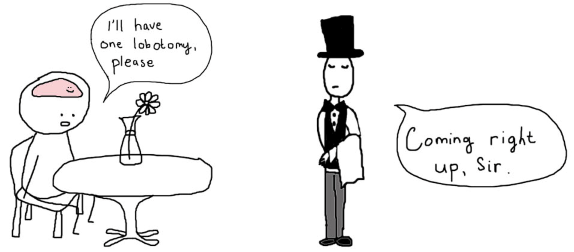NEW: audio commentary now available! Have a listen before/after the article 🙂
Contrary to what your intuition may believe, looking forward to playing a tennis match on Sunday afternoon isn’t really about the tennis match at all.
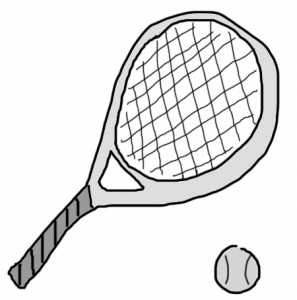
What makes your nightly ritual of blanket-slippers-tea-kindle special hasn’t got much to do with the activity of reading of all.
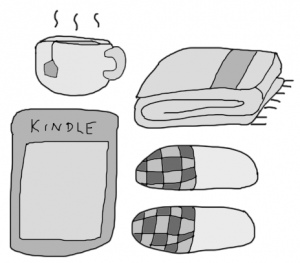
An overnight mountain climbing trip on the weekend offers something more than an arduous trek up unforgiving soil.

Your obsession with that local Thai joint is thanks to something more fundamentally true than how good their green curry sauce is.

Layered imperceptibly beneath all the above activities is a cardinal fact. A necessary truth, one ubiquitous to all human beings and applicable to every possible (un)pleasurable activity. A truth that shapes decision-making and the design of one’s lifestyle.
Every action, activity, hobby, or ritual is nothing more than the pursuit of a certain mental state.
But what about unpleasant activities? Are you saying there’s sane people out there that chase the characterising anguish of a root canal? Not quite. Many ‘unpleasant’ activities have initial costs, struggles or sacrifices that are necessary to reach a delayed, yet positive mental state. Think voluntary military recruits: gruelling training and unbearable conditions for the delayed feeling of patriotism and camaraderie; child birth: incalculable agony for the delayed reward of bringing life into this world; meditation retreats: an exchange of enduring an aching body and restless mind for the eventual reward of peace and equanimity.
Let’s revisit the 4 initial examples above:
The idea of a tennis match excites us not because we’re looking forward to swinging an aluminum racket back and forth in a white outfit. Rather, we’re chasing the mental state of the resulting adrenaline following a second consecutive ace. The mental state of intense bonding through sport. The mental state of the vitality we feel from the harmony of our muscles and bones working in unison to execute perfect technique.
The ‘blanket-slippers-tea-kindle’ combo (disclaimer: I do this and it’s awesome) is nested in the associated comfort that the ritual gives. At its core, it’s a habitual attempt to calm down an active brain and lull it to sleep. Which is, intrinsically, the nightly pursuit of the mental state of relaxation and feeling at ease.
Passionate alpinists have something else rolled up under their Merino sleeves. Coated underneath all those Ziploc bags of food and uncomfortable nights of sleep is an unshakeable will and determination to conquer a specific goal. Although traversing a mountain feels strenuous and at times unbearable, mountaineering is no exception to the aforementioned cardinal truth; the hunt for the feeling of accomplishment, earning something, and overcoming a fixed barrier are all, at their core, mental states.
The Thai restaurant is no exception: eating there boils down to the unmistakeable mental states of satiety and gastronomic familiarity that you’ve come to integrate as a staple in your life.
An average week, then, could look something like this:
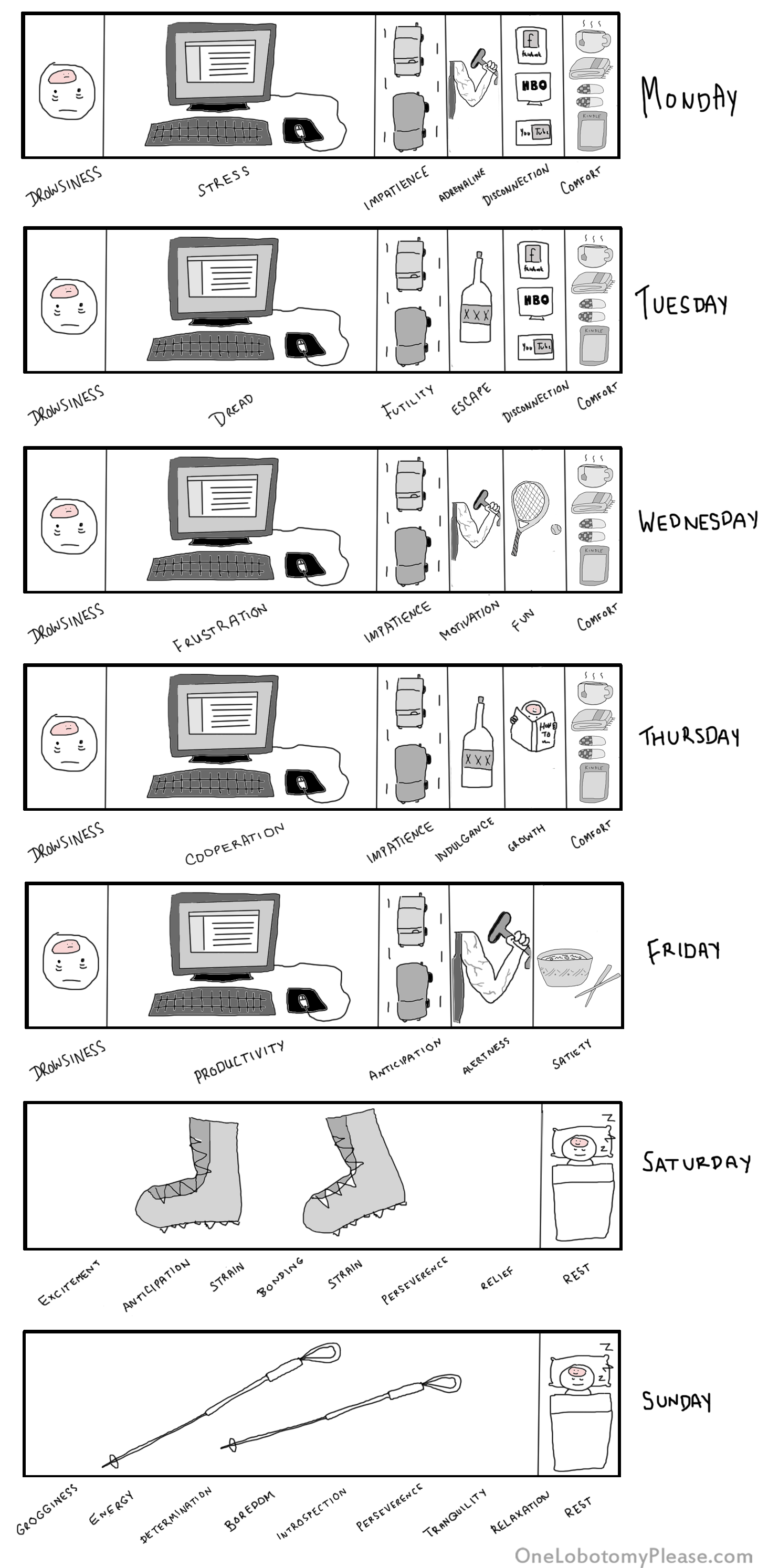
Let’s strip away the activities above and focus entirely on their produced mental states. An average week—no less accurate than the picture above—would look something like this:
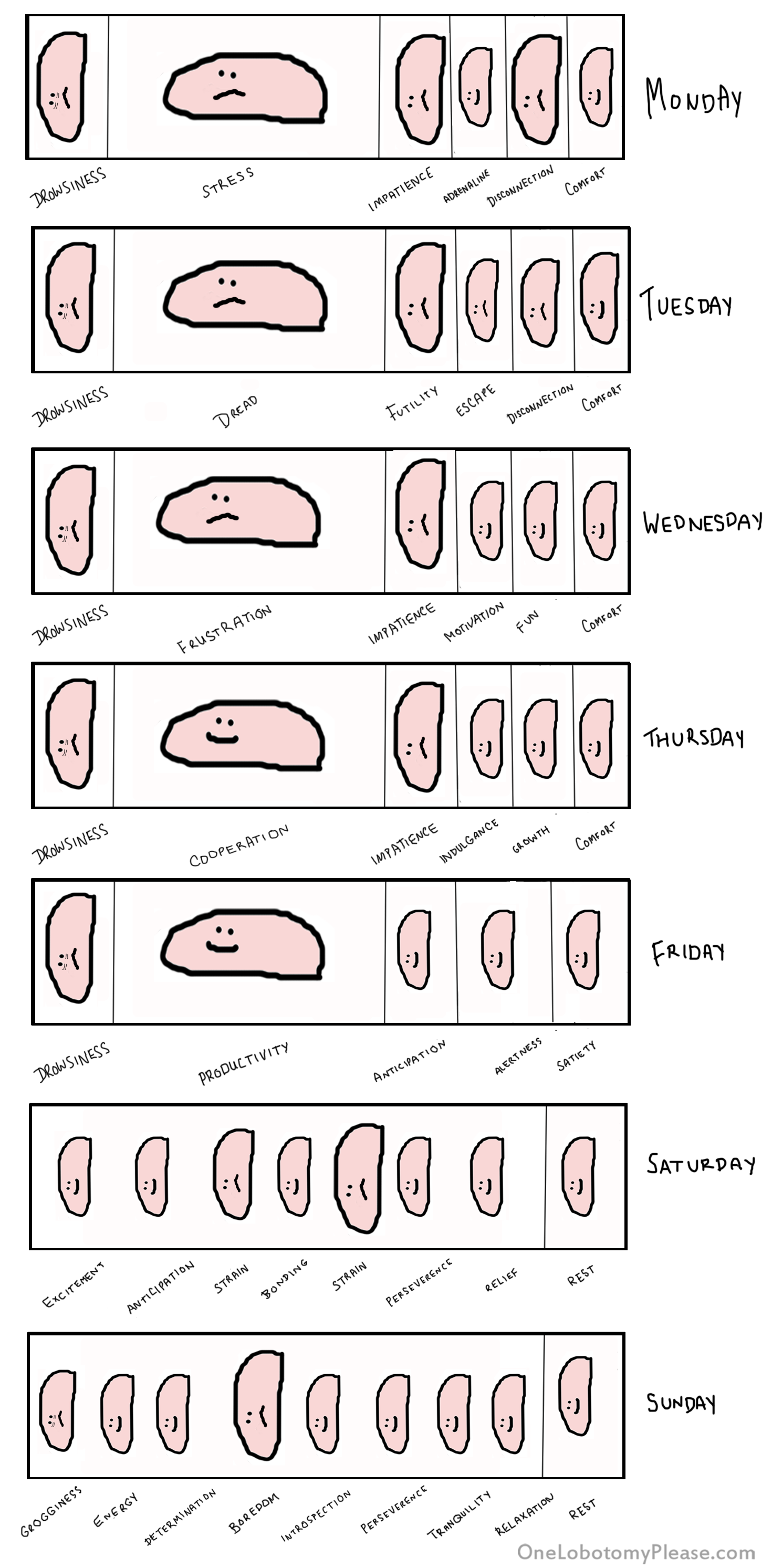
Experientially, an entire week is nothing more than a collection of mental states.
What’s the point?
Good question. If you’re with me so far, you’ll agree that a mental state, not the activity itself, is the defining feature that encapsulates what it’s like to experience something. What does this imply? And more importantly, how do we apply this knowledge to improve our lives?
The realization that we pursue mental states, rather than activities can empower us to make better decisions. By default, we tend to first plan a future activity based on its raw description (a new electronic music festival is announced for the upcoming summer), rather than the potential mental state(s) it will bring us. Doing it the other way around—focusing first on potential emotions or states of being that an event promises—could offer a more insightful, personalized way to make decisions. A more fruitful mental dialogue would focus on the potential spectrum of available mental states that a festival atmosphere can offer, not on the act of attending the festival itself. Relevant examples include: “how do festivals make me feel?” “Do I identify with electronic music festival culture, or will I be attending because it’s the trendy thing to do?” “Does the idea of a huge crowd energize me or overwhelm me?”
An increased focus on attractive mental states could allow us to design a more fulfilling lifestyle. It would be prudent to create goals based on how you want to be feeling not what you want to be doing. It’s far too easy to conflate societally driven notions of happiness and success with what truly makes us feel good. What kind of mental state arises when we’re in an environment that’s high or low pressure? Are we made content by simple, rather than elaborate explanations? Are we pensive or spontaneous? We ought to spend some time reflecting about the kinds mental states we thrive from and plan our weeks/months/years appropriately.
There are economic implications, too. Concentrating on filling our lives with gratifying mental states can help us make better financial decisions. Do our pricy hobbies or possessions give us the same fulfillment as our simple and inexpensive ones? If they give more fulfilment… how much more? Is it worth increasing our pleasure ceiling for it/them?
Thinking of life as a collection of mental states allows us to take full control of our emotional health. We can take greater control of our conscious, living experience and try optimising it to its greatest potential. Cliché though no less true, meditation is the key to doing so. Meditation’s crucial promise—the ability to take the reins of the present moment—spells out lesser attachment to negative mental states and increased mindfulness in daily life activities.
Expanding the metaphor
Certain mental states can dominate weeks, months, years or even decades of our lives. Many times when we reflect back on a certain period in our life, there appears one distinct state that can most accurately summarize what it was like to be alive then. One may describe their early childhood as an undeniable period of:
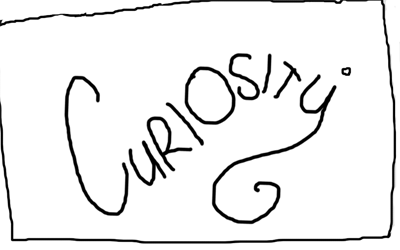
Which was followed by an adolescence of:
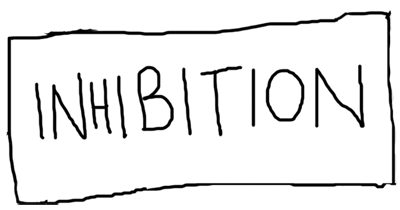
With their later teenage years having the distinct sensation of:
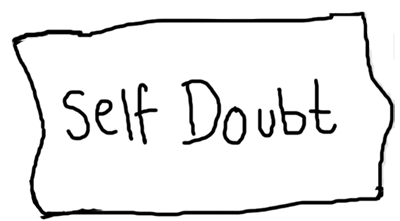
As formative mental states stack up over the years, a macro snapshot of our life can start to look something like this:
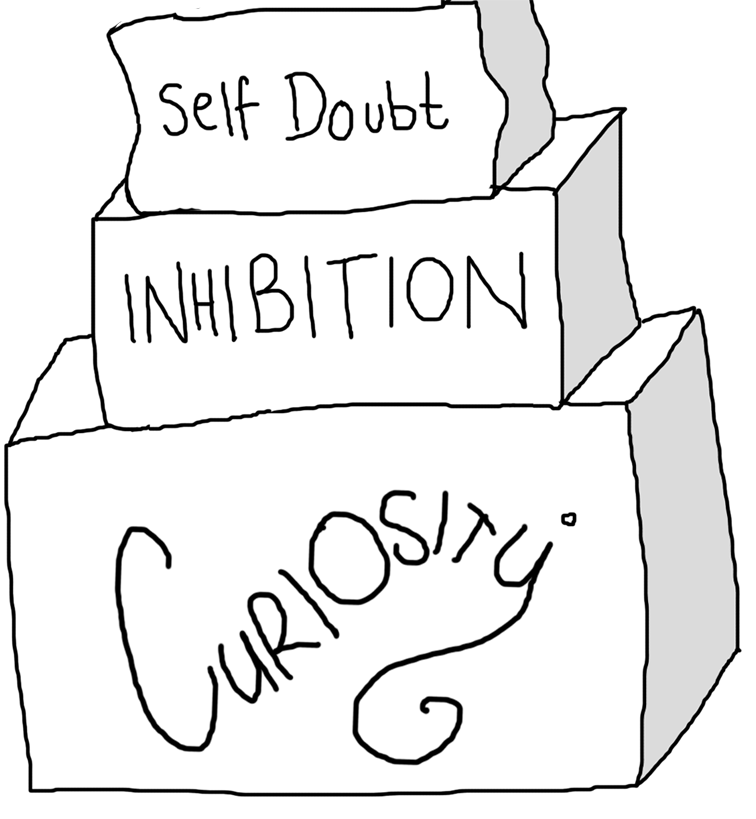
As we reach our golden years and our stacks of dominant mental states have reached their zenith, entire lifetimes could look something like this:
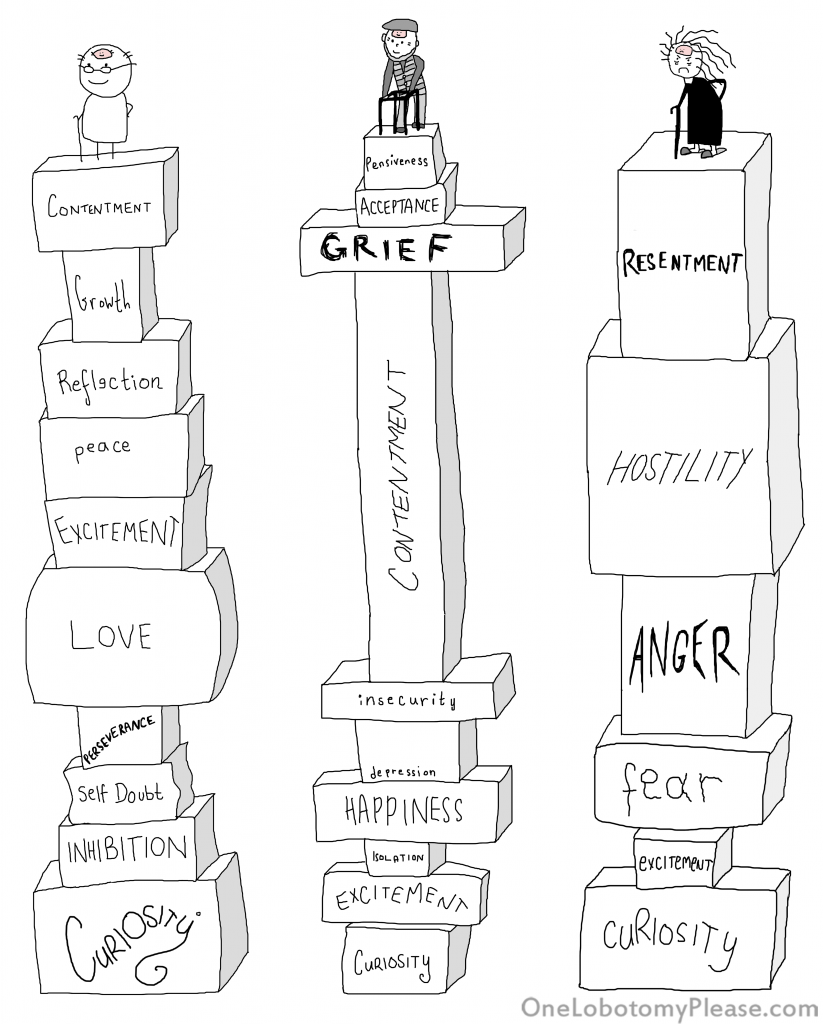
Final Words
When broken down into experiential pieces, life is merely the sequential accumulation of various mental states. Mental states can be pleasant or unpleasant, but ultimately, are temporary. We should try to make our bumpy ride on Earth in the only vehicle we’ve got (human life) as pleasant as possible, and avoid getting too upset when it’s not. The roads we take and paths we choose may sound luring and attractive, but, crucially, the essence of our journey is how it makes us feel.
We should strive to reach old age with a healthy ‘stack’ of mental states that we can compassionately look back on with a smile. Every one of our stacks will look distinctly, be weighed differently, and will inevitable define our finite existence. And this is perfectly ok, since we all have vastly differing ideas of what a healthy, self-actualized life looks like. The most important thing is to push on and reach the end line, having accomplished the most valuable thing: a life well lived.
What will your stack of mental states look like when you’re older?
